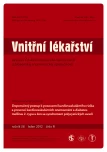Common, standardized and recommended approaches in the diagnosis and monitoring of paroxysmal nocturnal haemoglobinuria using flow cytometry
Authors:
I. Marinov1ihash2ihash4 ,2 ,2 ,2
Authors‘ workplace:
Ústav hematologie a krevní transfuze Praha, ředitel prof. MUDr. Marek Trněný, CSc.
1; Ústav klinické a experimentální hematologie 1. lékařské fakulty UK a Ústavu hematologie a krevní transfuze Praha, přednosta prof. MUDr. Marek Trněný, CSc.
2
Published in:
Vnitř Lék 2012; 58(1): 31-37
Category:
Reviews
Overview
Paroxysmal nocturnal hemoglobinuria is an acquired clonal disease characterized by proliferation of stem cells, deficient of proteins linked to the membrane via glycophosphatidylinositol (GPI) anchors. PNH cell characterization by flow cytometry was introduced in 1986, since 1996 is considered as method of choice for PNH diagnosis. Flow cytometry PNH analysis is nowadays crucial for disease monitoring in terms of progression, regression, remission or response to therapy and screening for small PNH clones (< 1.0%) in patients with aplastic anemia or myelodysplastic syndrome. Flow cytometry is unfortunately still poorly standardized, there is a variety of different methodological approaches for PNH evaluation and results from external quality assurances schemes reveal heterogeneous results. The aim of this work is to review the applicability of flow cytometry for the diagnosis and monitoring of PNH with respect to our experience and in the context of the recent trends and guidelines for PNH evaluation by flow cytometry.
Key words:
paroxysmal nocturnal hemoglobinuria – flow cytometry – standardized approaches
Sources
1. Oni SB, Osunkoya BO, Luzzatto L. Paroxysmal nocturnal hemoglobinuria: Evidence for monoclonal origin of abnormal red cells. Blood 1970; 36 : 145–152.
2. Moyo VM, Mukhina GL, Garrett ES et al. Natural history of paroxysmal nocturnal haemoglobinuria using modern diagnostic assays. Br J Haematol 2004; 126 : 133–138.
3. Bessler M, Mason PJ, Hillmen P et al. Paroxysmal nocturnal hemoglobinuria (PNH) is caused by somatic mutations in the PIG-A gene. EMBO J 1994; 13 : 110–117.
4. Nafa K, Bessler M, Castro-Malaspina H et al. The spectrum of somatic mutations in the PIG-A gene in paroxysmal nocturnal hemoglobinuria includes large deletions and small duplications. Blood Cells Mol Dis 1998; 24 : 370–384.
5. van der Schoot CE, Huizinga TW, van’t Veer-Korthof ET et al. Deficiency of glycosyl-phosphatidylinositol-linked membrane glycoproteins of leukocytes in paroxysmal nocturnal hemoglobinuria, description of a new diagnostic cytofluorometric assay. Blood 1990; 76 : 1853.
6. Hillmen P, Bessler M, Mason PJ et al. Specific defect in N-acetylglucosamine incorporation in the biosynthesis of the glycosylphosphatidylinositol anchor in cloned cell lines from patients with paroxysmal nocturnal hemoglobinuria. Proc Natl Acad Sci USA 1993; 90 : 5272–5276.
7. Yamashina M, Ueda E, Kinoshita T et al. Inherited complete deficiency of 20-kilodalton homologous restriction factor (CD59) as a cause of paroxysmal nocturnal hemoglobinuria. N Engl J Med 1990; 323 : 1184–1189.
8. Motoyama N, Okada N, Yamashina M et al. Paroxysmal nocturnal hemoglobinuria due to hereditary nucleotide deletion in the HRF20 (CD59) gene. Eur J Immunol 1992; 10 : 2669–2673.
9. Parker C, Omine M, Richards S et al. International PNH Interest Group. Diagnosis and management of paroxysmal nocturnal hemoglobinuria. Blood 2005; 106 : 3699–3709.
10. Hillmen P, Lewis SM, Bessler M et al. Natural history of paroxysmal nocturnal hemoglobinuria. N Engl J Med 1995; 333 : 1253–1258.
11. Hill A, Hillmen P, Richards SJ et al. Sustained response and long-term safety of eculizumab in paroxysmal nocturnal hemoglobinuria. Blood 2005; 106 : 2559–2565.
12. Hillmen P, Richards SJ. Flow cytometry in PNH: Serial analysis and the prediction of outcome (abstract). Blood 1999; 94 (S1): 412a.
13. Richards SJ, Cullen MJ, Dickinson AJ et al. Evolution of GPI-deficient clones predicts clinical course in paroxysmal nocturnal haemoglobinuria. Blood 2004; 104 : 53a.
14. Richards SJ, Rawstron AC, Hillmen P. Application of flow cytometry to the diagnosis of paroxysmal nocturnal hemoglobinuria. Cytometry (Comm Clin Cytom) 2000; 42 : 223.
15. Borowitz MJ, Craig FE, Di Giuseppe JA et al. Clinical Cytometry Society. Cytometry. Part B. Clinical Cytometry 2010; 78B: 211–230.
16. Čermák J, Marinov I, Jelínek J. Clinical significance of CD55 and CD59 deficiency in patients with primary myelodysplastic syndrome. Blood 2000; 96 : 146–147a.
17. Hall SE, Rosse WF. The use of monoclonal antibodies and flow cytometry in the diagnosis of paroxysmal nocturnal hemoglobinuria. Blood 1996; 87 : 5332.
18. Olteanu H, Karanadikar NJ, McKenna RW et al. Differential usefulness of various markers in the flow cytometric detection of paroxysmal nocturnal hemoglobinurie in blood and bone marrow. Am J Clin Pathol 2006; 126 : 781–788.
19. Sutherland DR, Kuek N, Davidson J et al. Diagnosing PNH with FLAER and Multiparameter Flow Cytometry. Cytometry B Clin Cytom 2007; 72B: 167.
20. Brodsky RA, Mukhina GL, Nelson KL et al. Resistance of paroxysmal nocturnal hemoglobinuria cells to the glycosylphosphatidylinositol-binding toxin aerolysin. Blood 1999; 93 : 1749–1756.
21. Granger V, Whitby L, Richards SJ et al. Development and evaluation of a stabilized whole-blood preparation as a quality control material for screening for paroxysmal nocturnal haemoglobinuria by flow cytometry (abstract). Cytometry B Clin Cytom 2005; 68B: 59.
Labels
Diabetology Endocrinology Internal medicineArticle was published in
Internal Medicine

2012 Issue 1
Most read in this issue
- Endocrine changes in liver disease
- Hyponatraemia associated with the syndrome of inappropriate antidiuretic hormone hypersecretion (SIADH) – options for treatment
- A detailed study of colon polyps
- Hyponatremia – carbamazepine medication complications
